How Can You Tell if a Raccoon is Sick?
Identifying a sick raccoon involves noting specific signs and symptoms including increased aggression, lethargy, or lack of coordination—potential indicators of neurological disorders like rabies or distemper. Physical injuries such as lacerations, swelling, or abscesses necessitate immediate veterinary intervention.
Respiratory issues, evidenced by labored breathing or nasal discharge, require treatment with antibiotics or antiparasitics. Changes in vocalizations or a poor coat condition suggest systemic health problems.
Lethargy, disorientation, and aggressive behavior also warrant urgent diagnostic evaluation. Documenting these observations can facilitate accurate reporting to wildlife authorities.
Insight into the nuances of these signs can greatly enhance understanding.
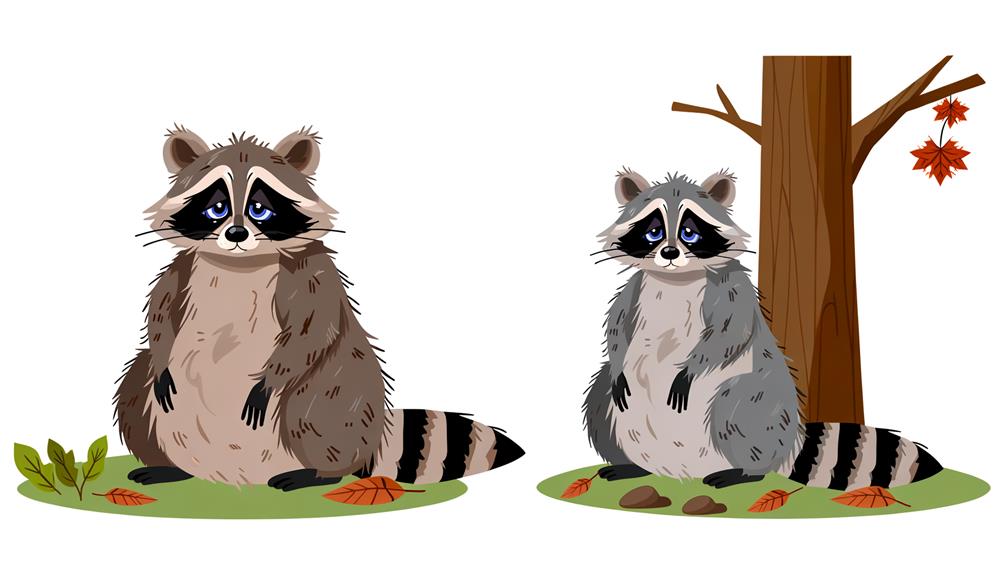
Key Takeaways
- Behavioral changes such as increased aggression or lethargy suggest neurological disorders like rabies or distemper.
- Visible injuries, including lacerations or swelling, indicate immediate veterinary intervention is required.
- Labored breathing or nasal discharge points to respiratory issues needing antibiotics and monitoring.
- Poor coat condition may signal ectoparasites, nutritional deficiencies, or systemic diseases.
- Disorientation or unusual vocalizations often indicate neurological or systemic health issues requiring prompt veterinary assessment.
Behavioral Changes
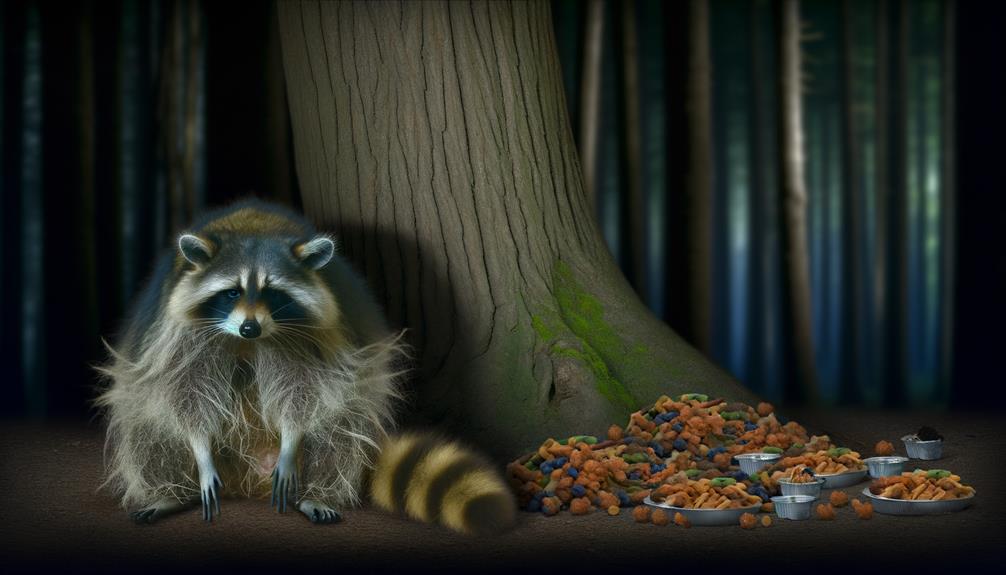
Behavioral changes in raccoons, such as increased aggression, lethargy, or a lack of coordination, can often be indicative of underlying illness. These symptoms may suggest neurological disorders, such as rabies or distemper, which can alter the central nervous system's functionality.
Clinically, aggression may be attributed to encephalitis, whereas lethargy could stem from metabolic imbalances or systemic infections. Lack of coordination, or ataxia, often points to vestibular dysfunction or toxin exposure.
Diagnostic approaches should include thorough clinical examination, neurological assessment, and possibly serological testing to identify pathogens. Early detection and intervention are pivotal in managing these conditions, both for the welfare of the animal and public health considerations.
Understanding these signs enables timely and appropriate medical intervention.
Visible Injuries
When evaluating a raccoon for illness, visible injuries such as lacerations and cuts are critical diagnostic indicators. Observing limping or signs of immobility can suggest musculoskeletal trauma or neurological impairment.
Additionally, the presence of swelling and infections may indicate underlying systemic issues or localized abscesses requiring immediate veterinary intervention.
Lacerations and Cuts
Visible injuries, such as lacerations and cuts, are immediate indicators of potential health issues in raccoons and warrant thorough examination and prompt intervention. Lacerations, defined as deep, irregular tears in the skin, can lead to significant blood loss, infection, and secondary complications. When examining a raccoon, it is vital to assess the depth, location, and extent of the wound.
Cuts, or incised wounds, are generally cleaner but still pose a risk for bacterial contamination and should be treated with antiseptics and appropriate bandaging. Immediate veterinary care is essential to prevent sepsis and facilitate proper healing. Additionally, observing the raccoon's behavior, such as excessive grooming or scratching at the site, can provide further insight into the severity of the injury.
Limping or Immobility
Limping or immobility in raccoons can be indicative of fractures, sprains, or joint dislocations, necessitating a thorough orthopedic examination to determine the underlying cause.
Observing the animal's gait and conducting a physical examination are essential first steps. Palpation of the affected limb may reveal abnormalities such as crepitus, misalignment, or localized pain.
Radiographic imaging is often required to confirm the diagnosis and to assess the extent of skeletal damage. Differential diagnoses, such as nerve injuries or soft tissue trauma, should also be considered.
Immediate immobilization and pain management are critical to prevent further injury. A prompt, accurate diagnosis followed by appropriate intervention can greatly enhance recovery outcomes for the affected raccoon.
Swelling and Infections
Swelling and infections in raccoons, often manifesting as visible injuries, can signal underlying abscesses, cellulitis, or systemic infections that require immediate veterinary attention.
Clinically, these signs may include localized heat, erythema, and edema. Abscesses, often caused by bacterial infiltration due to bites or punctures, can lead to systemic spread if untreated. Cellulitis, a bacterial skin infection, presents with diffuse swelling and pain upon palpation.
Diagnostic approaches involve physical examination, fine-needle aspiration for cytology, and bacterial cultures to identify pathogens. Immediate intervention with appropriate antibiotics and, if necessary, surgical drainage of abscesses is important.
Monitoring for signs of systemic involvement, such as lethargy or fever, is vital to prevent septicemia and ensure a successful recovery.
Respiratory Issues
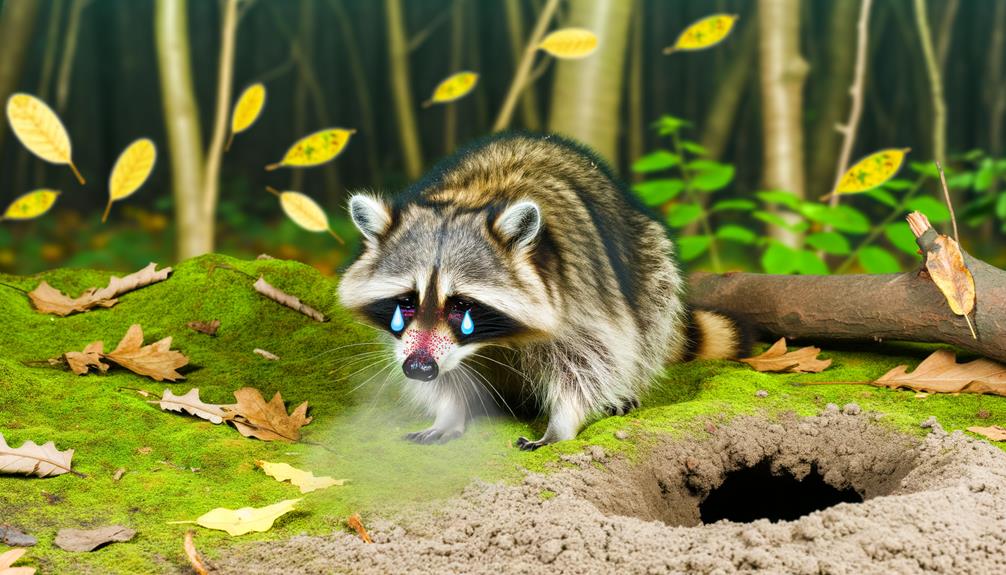
Respiratory issues in raccoons often manifest through clinical signs such as labored breathing, nasal discharge, and audible wheezing. These symptoms may indicate a range of underlying conditions, including bacterial or viral infections, parasitic infestations, or even environmental irritants. Diagnostic approaches typically involve a thorough physical examination, auscultation of the lungs, and potentially radiographic imaging to assess lung integrity.
Nasal swabs and blood tests can also help identify specific pathogens. Effective treatment depends on the accurate diagnosis of the underlying cause and may include antibiotics, antiparasitics, or supportive care such as fluid therapy and nebulization. Monitoring for secondary complications, such as pneumonia, is vital to ensure all-encompassing care and recovery for the affected raccoon.
Unusual Noises
When evaluating the health of a raccoon, clinicians should pay close attention to any unusual vocalizations. Changes in vocalization patterns, such as increased daytime chattering or distinct distress calls, can be indicative of underlying medical conditions or stress.
Careful auditory observation paired with a thorough clinical examination can aid in accurate diagnosis and timely intervention.
Vocalization Changes
Alterations in vocalization, including the production of atypical noises, can serve as a crucial indicator of underlying illness in raccoons. Changes in the usual repertoire of sounds such as growls, whispers, or purrs may suggest neurological disorders, respiratory infections, or pain-induced distress. Clinicians should employ a systematic approach to assess these vocalization changes, noting the frequency, type, and context of the noises.
Differential diagnosis may involve ruling out rabies, canine distemper, or upper respiratory tract infections. Detailed auditory examination, combined with a thorough physical assessment, aids in identifying the etiology. Persistent or erratic vocalizations warrant immediate attention, as they often correlate with significant health issues necessitating prompt intervention and treatment.
Daytime Chattering
Daytime chattering, characterized by high-pitched or continuous noises during daylight hours, can be a significant clinical sign of potential neurological or infectious diseases in raccoons.
Typically nocturnal, raccoons exhibiting vocalization during the day may indicate altered neurological function due to conditions such as rabies, distemper, or toxoplasmosis.
Diagnostic evaluation should include a thorough history, physical examination, and laboratory testing, focusing on cerebrospinal fluid analysis and serological tests to identify pathogens.
It is essential to take into account differential diagnoses like trauma-induced brain injury or encephalitis.
Prompt recognition and intervention are crucial for both the affected raccoon and public health, as some of these conditions are zoonotic.
Veterinary consultation is advised to establish a definitive diagnosis and appropriate management plan.
Distress Calls
In addition to daytime chattering, distress calls manifesting as unusual noises can serve as critical indicators of underlying health issues in raccoons, warranting immediate veterinary assessment. These vocalizations may include growling, whining, or high-pitched screeching, often signaling pain, discomfort, or neurological distress. Clinicians should be vigilant in recognizing these auditory cues, as they may correlate with conditions such as rabies, distemper, or respiratory infections.
| Distress Call | Possible Condition | Recommended Action |
|---|---|---|
| Growling | Pain or injury | Immediate veterinary visit |
| Whining | Respiratory issues | Diagnostic imaging |
| High-pitched screeching | Neurological problems | Neurological examination |
Accurate identification and timely intervention are paramount to mitigate the progression of potentially life-threatening conditions in raccoons.
Poor Coat Condition
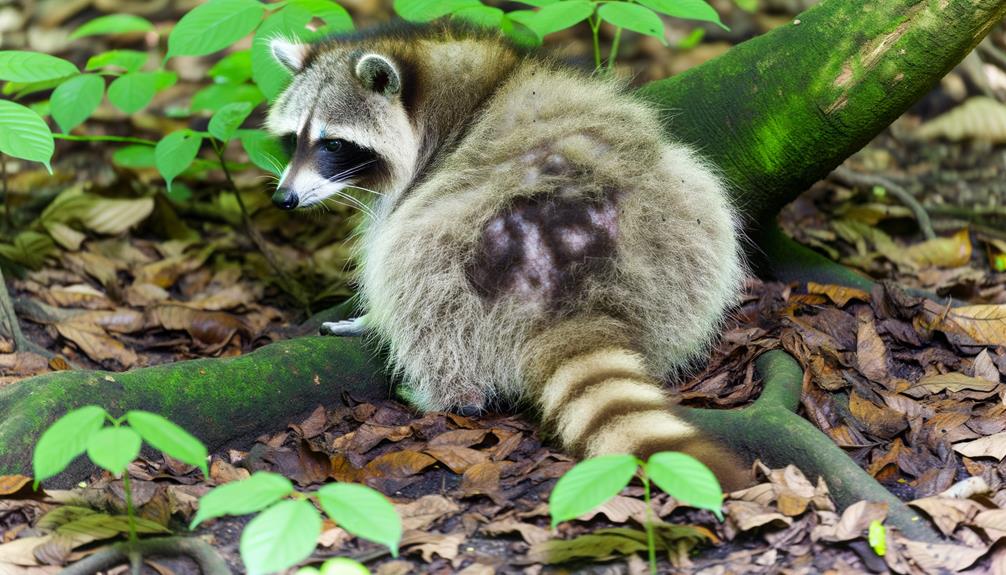
A raccoon exhibiting poor coat condition may be indicative of underlying health issues such as parasitic infestations, nutritional deficiencies, or systemic diseases. Veterinary examination often reveals ectoparasites like mites, fleas, or ticks, which can cause alopecia, pruritus, and dermatitis.
Nutritional deficiencies, particularly in essential fatty acids or protein, can lead to a dull, brittle coat. Systemic diseases, including metabolic disorders and chronic infections, may impair skin health and fur quality.
Diagnostic approaches include skin scrapings, blood tests, and nutritional assessments to identify specific etiologies. Observing for additional clinical signs, such as crusting, scaling, or erythema, can aid in pinpointing the underlying condition.
Early detection and appropriate intervention are essential for improving the affected raccoon's health and coat condition.
Lethargy and Weakness
Lethargy and weakness in raccoons are often clinical indicators of systemic illness, necessitating thorough diagnostic evaluation. These symptoms may manifest due to a myriad of underlying conditions, including viral infections, parasitic infestations, or metabolic disorders. A raccoon exhibiting lethargy and weakness should be promptly assessed by a wildlife veterinarian to identify the root cause and initiate appropriate treatment. Diagnostic tests such as blood work, fecal analysis, and imaging studies can provide insights into the animal's health status.
Heartbreaking vulnerability: A once dynamic creature now struggles to move.
Silent suffering: Pain that's not always evident.
Critical need for care: Swift action can save lives.
Wildlife preservation: Safeguarding these animals maintains ecological balance.
Emotional toll: Witnessing their decline is distressing for caregivers.
Disorientation

Disorientation in raccoons is another critical symptom that may indicate neurological or systemic issues requiring immediate veterinary evaluation. Manifestations of disorientation include aimless wandering, difficulty in maintaining balance, and apparent confusion about surroundings.
Such symptoms may be attributable to various etiologies, including infectious diseases like rabies or distemper, toxic ingestions, or traumatic brain injuries. A thorough diagnostic approach involves neurological examinations, blood tests, and imaging studies to identify underlying causes.
Early identification and intervention are essential to mitigate the progression of the condition and prevent potential transmission of zoonotic diseases. Observing these signs in a raccoon should prompt immediate contact with wildlife professionals or veterinarians for appropriate handling and treatment.
Aggressive Behavior
Exhibiting uncharacteristic aggressive behavior in raccoons may signify underlying health issues such as infectious diseases, neurological disorders, or extreme stress, necessitating immediate professional evaluation. Aggression in raccoons can be indicative of rabies, canine distemper, or toxoplasmosis, each requiring a different diagnostic and therapeutic approach. Observing such behavior is pivotal for public health and animal welfare.
Understanding these symptoms can facilitate timely intervention.
- Erratic, unprovoked attacks: A visible sign of potential rabies or severe neurological impairment.
- Unusual vocalizations: Growling or hissing more frequently than normal.
- Daytime activity: Raccoons are nocturnal by nature; daytime aggression is abnormal.
- Self-mutilation or biting: Indicative of extreme distress or neurological dysfunction.
- Increased territoriality: Excessive guarding of food or dens can signal health issues.
What to Do
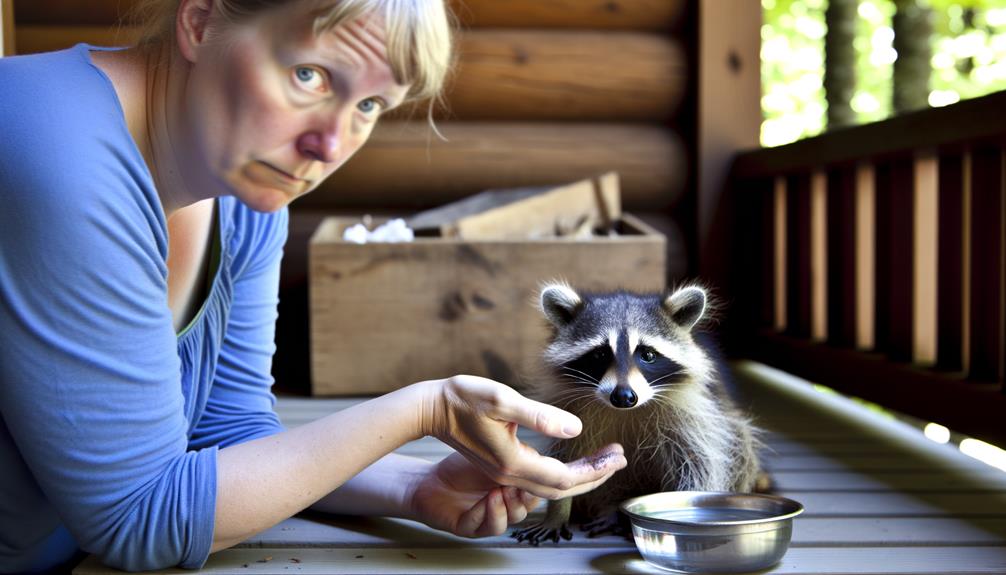
Recognizing aggressive behavior as a potential indicator of illness in raccoons requires immediate action to prevent harm and secure appropriate treatment. Initially, maintain a safe distance to avoid potential zoonotic disease transmission.
Contact local wildlife authorities or animal control professionals equipped to handle potentially sick wildlife. If feasible, document the raccoon's behavior for accurate reporting. Avoid attempting capture or treatment without proper protective equipment, as rabies and distemper are common in symptomatic raccoons.
A wildlife rehabilitator or veterinarian should assess the animal for definitive diagnosis and management. Timely intervention not only safeguards public health but also secures humane treatment of the affected raccoon.
Prioritize professional involvement to mitigate risks and secure a clinically sound approach.
Conclusion
Coincidentally, the convergence of behavioral changes, visible injuries, respiratory issues, unusual noises, poor coat condition, lethargy, disorientation, and aggressive behavior in a raccoon can be indicative of underlying illness.
A thorough evaluation of these clinical signs, when observed simultaneously, provides a compelling diagnostic framework for determining the health status of the animal.
Consequently, prompt intervention by wildlife professionals is crucial to address potential zoonotic risks and guarantee appropriate care for the affected raccoon.






